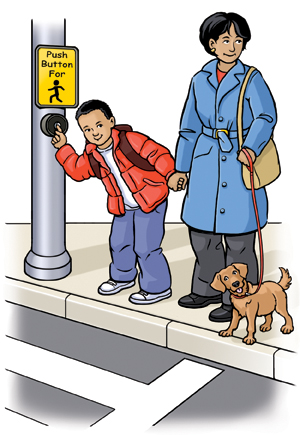Teaching Children Pedestrian Safety
Most adults know the rules of walking safely on the road. But children have to be taught how to stay safe. This sheet tells you how to teach your child to be a safe pedestrian.
 |
| Teach your child to obey all traffic signs and signals when walking on or near the road. |
Why teach your child pedestrian safety?
Young children don’t yet have the skills needed to cross a street safely. This is especially true of kids younger than 10 years old. Keep in mind that young children:
-
Are impulsive. They often run out into the street unexpectedly, perhaps chasing a ball.
-
Have limited attention spans and can be easily distracted. And they may have trouble putting together all of the pieces involved with crossing the street safely.
-
Are shorter than adults. Most are under 4 feet tall. So they may find it hard to see above or around obstacles such as parked cars or bushes. Also, drivers may find it hard to see them.
-
Have limited side (peripheral) vision. This means a child looking straight ahead may have trouble seeing movement to the side. So, a child must be taught to turn their head when looking for traffic.
-
Have trouble locating sounds. A child may not be able to tell what direction a car is coming from.
-
Have limited perception of speed and distance. A child may not be able to tell how fast a car is going, or how far away a car is.
-
May not realize that just because they see a driver doesn't mean the driver can see them.
-
May not understand the danger of traffic. Children may not grasp the idea that a vehicle could hurt or kill them.
Road safety for walkers
There are important “Dos” and “Don’ts” that all pedestrians should follow. Teach these to your child to keep them safe when walking on and near the road. They include:
-
DO recognize and obey all traffic signs and signals. This includes “Walk” and “Don’t Walk” signs. Be sure the child knows to continue to walk even if a light changes to “Don’t Walk” while they are in the crosswalk.
-
DO walk on the sidewalk whenever possible. If there is no sidewalk, pedestrians should walk as far away from traffic as possible, facing traffic.
-
DO stop and look before crossing driveways and alleys.
-
DO pay extra attention in bad weather. Drivers may find it harder to see walkers, and it may be harder for drivers to stop.
-
DO always listen to crossing guards and follow their signals.
-
DO look for white lights on the back of a car that indicate the car is backing up.
-
DO pay special attention at railroad crossings. Remind your child that trains can be very dangerous.
-
DO cross streets only at corners or at crosswalks.
-
DO be alert and aware at all times.
-
DO cross streets carefully. Every walker should:
-
Stop at the curb at a corner or crosswalk.
-
Look left, right, and left again, making sure no vehicles are approaching.
-
Make eye contact with any nearby drivers before crossing.
-
Make sure cars have come to a complete stop before crossing.
-
Walk, not run, across the crosswalk, still looking left and right.
-
DON’T cross the street between parked cars.
-
DON’T ever run into the street.
-
DON’T play in streets, parking lots, driveways, or unfenced yards by the street.
Walking with your child
When walking near a road with your child:
-
Use the time to teach your child about pedestrian safety.
-
Hold your child’s hand at all times.
-
Have your child wear bright colors so drivers can see them more easily. In low light, children should wear reflective materials.
-
Teach your child to make safety decisions. As your child gets older, help them develop safety judgment. For instance, while crossing the street, explain why you think it’s safe to cross at a particular time. Ask if your child agrees.
-
If your child walks to school:
-
Walk with your child the first several times to help them find a direct route with few street crossings.
-
Have your child stick to a safe route, one with adult crossing guards at each intersection.
-
Encourage your child to walk with an older student or a buddy.
-
Explain to your child that it's not safe to use a cell phone or text while walking.
Safety tips for drivers
As a driver, you can take steps to make it safer for children walking near the road. These steps include the following:
-
Reduce your speed, especially in residential neighborhoods and near schools.
-
Check for children when backing out of a driveway or parking space. Also, look for children who may suddenly dart out into the road.
-
Don’t be distracted while driving. Don't use a cell phone, eat, or play with the radio while driving.
-
Stop completely at stop signs. And don’t cover the crosswalk.
-
If you see a situation that might be dangerous for pedestrians, report it to your local government or police department.
Online Medical Reviewer:
Amy Finke RN BSN
Online Medical Reviewer:
Liora C Adler MD
Online Medical Reviewer:
Stacey Wojcik MBA BSN RN
Date Last Reviewed:
1/1/2022
© 2000-2024 The StayWell Company, LLC. All rights reserved. This information is not intended as a substitute for professional medical care. Always follow your healthcare professional's instructions.